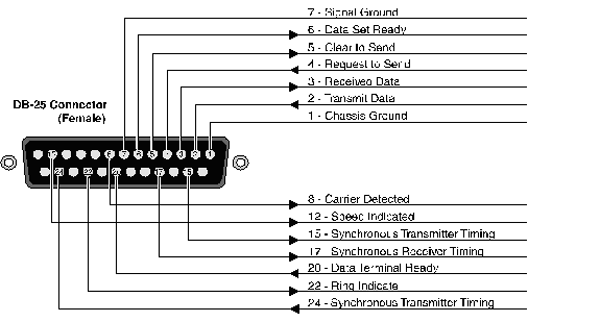
Your modem uses multiple standard data communications protocols and is also compatible with many nonstandard schemes. The following schemes are supported:
| This modulation | Supports |
| V.90 and V.92 | ITU 56K standard, server capabilities. 56 through 28 kbps; Pulse Coded Modulation (PCM). |
| ITU-T V.34 | 33.6/31.2/28.8/26.4/24/21.6/19.2/16.8/14.4/12 kbps; 9600/7200/4800 bps asynchronous Trellis Coded Modulation (TCM) |
| V.FC | 28.8/26.4/24/21.6/19.2/16.8/14.4 kbps asynchronous TCM |
| V.32 terbo | 21.6/19.2/16.8/14.4/12 kbps; 9600/7200 bps asynchronous TCM; 4800 bps asynchronous Quadrature Amplitude Modulation (QAM) |
| HST | 16.8/14.4/12 kbps; 9600/7200 bps asynchronous, asymmetrical, 450 bps back channel with automatic handshake adjustment to 300 bps TCM and QAM; 4800 bps asynchronous, asymmetrical, 450 bps back channel with automatic handshake adjustment to 300 bps QAM. |
| ITU-T V.32 bis | 14.4/12 kbps; 9600/7200 bps asynchronous TCM; 4800 bps asynchronous QAM |
| ITU-T V.32 | 9600 bps asynchronous, TCM; 4800 bps asynchronous, QAM |
| ITU-T V.22 bis | 2400 bps asynchronous, QAM |
| Bell 212A | 1200 bps (also V.22) asynchronous, Differential Phase Shift Keying (DPSK) |
| ITU-T V.23 | 1200 bps asymmetrical with 75 bps back channel with Frequency Shift Keying (FSK), used by some U.K. and European phone systems. |
| Bell 103 | 300 bps (ITU-T V.21 optional) asynchronous, Frequency Shift Keying (FSK) |
| This modulation | Supports |
| ITU-T V.42 | LAPM error control, 1200 bps and higher |
| MNP | Levels 2, 3 and 4 error control, level 5 data compression, 1200 bps and higher |
| HST | Asymmetrical mode, at 16.8/14.4/12 kbps; 9600/ 7200/4800 bps, 450/300 bps back channel |
| ITU-T V.42 bis | Data compression, 1200 bps and higher |
| ITU-T V.54 | Digital and remote digital loopback testing |
| ITU-T V.25 bis | Dialing and answering method for automatic calling and/or answering equipment |
Your Courier 56K Business Modem provides Group III -compatibility when controlled by Class 1 or Class 2.0 fax software. In addition, your Courier 56K Business Modem adheres to the following standards:
| This modulation | Supports |
| TIA/EIA-578 | Service Class 1 Asynchronous Facsimile DCE Control Standard |
| TIA/EIA-592 | Service Class 2.0 Asynchronous Facsimile DCE Control Standard |
| ITU-T V.17 | 14.4/12 kbps |
| ITU-T V.29 | 9600/7200 bps |
| ITU-T V.27 | ter 4800/2400 bps |
| ITU-T V.21 | 300 bps |
| This feature | Supports | ||
| Supported serial port rates | 230400, 115200, 57600, 38400, 19200, 9600, 4800, 2400, 1200, and 300 bps | ||
| Adaptive Speed Leveling (ASL) | 21600, 19200, 16800, 14400, 12000, 9600, 7200, and 4800 bps | ||
| Serial port connector | DB-25 | ||
| Communications channel | Full- or half- duplex on 2-wire phone lines; demand-driven high-speed turnaround in HST mode; symmestrical speeds in V.32 bis. | ||
| Data format | Binary, serial; defaults to 8-bit word length, no parity, and 1 stop bit. | ||
| Word Length | Parity (1 Bit) | Stop Bits | |
| 7 | Even, odd, mark, space | 1 | |
| 7 | None | 2 | |
| 8 | None | 1 | |
| Flow Control Buffers | Variable sizes | ||
| Command Buffer | 56 characters, excluding the AT prefix, Carriage Return, and spaces | ||
| Test Options | Remote digital loopback, digital loopback, test pattern, and dial test | ||
| Failed Call Timeout | 60 second default, programmable 2-255 sec. | ||
| Answer Tone Timeout | 60 seconds | ||
| Answer Tone Detector | 2080-2120 Hz | ||
| Loss of Carrier (Disconnect Timer) | 0.7 second default, programmable 0.2-25.5 sec. | ||
| Equalization | Adaptive | ||
| Receive Sensitivity | - 43 dBm + 2 dBm | ||
| Transmit Level | - 9 dBm maximum | ||
| Transmitter Frequency Tolerance | .01% | ||
| Certification | FCC 15, EN55022 (CISPR 22), ICES-003, AS/NZS3548, VCCI; Class B; EN50082-1; UL/C-UL, IEC 950, EN60950, TS001; FCC 68, CTR 21 | ||
| Ringer equivalence | 0.4b | ||
Most computers provide a DB-25 or DB-9 port that conforms to the EIA-232 standard.
Your modem’s serial port is factory set to signal according to the EIA-232 standard.

DB-9 connectors for PCs should be wired at the computer end of the cable
as shown below.

Some computer/terminal equipment supports only a few of your modem’s EIA-232 signals. The minimum required for your modem to operate asynchronously follows:
| DB-25 | DB-9 | Supports this signal |
| Pin | Pin | Function |
| 2 | 3 | Transmitted Data |
| 3 | 2 | Received Data |
| 7 | 5 | Signal Ground |
| 20 | 4 | Data Terminal Ready |
If your computer and software support Clear to Send and you wish to use Transmit Data hardware flow control (&H1), Pin 5 (DB-25) or Pin 8 (DB-9) is required.
If your computer and software support Request to Send and you wish to use Received Data hardware flow control (&R2), Pin 4 (DB-25) or Pin 7 (DB-9) is required.